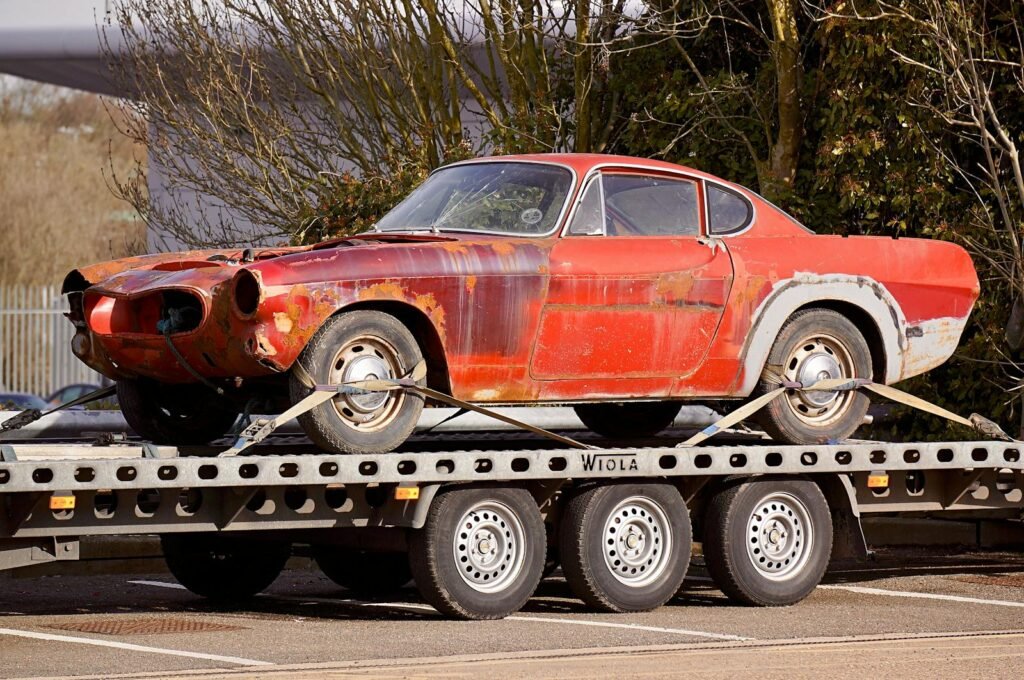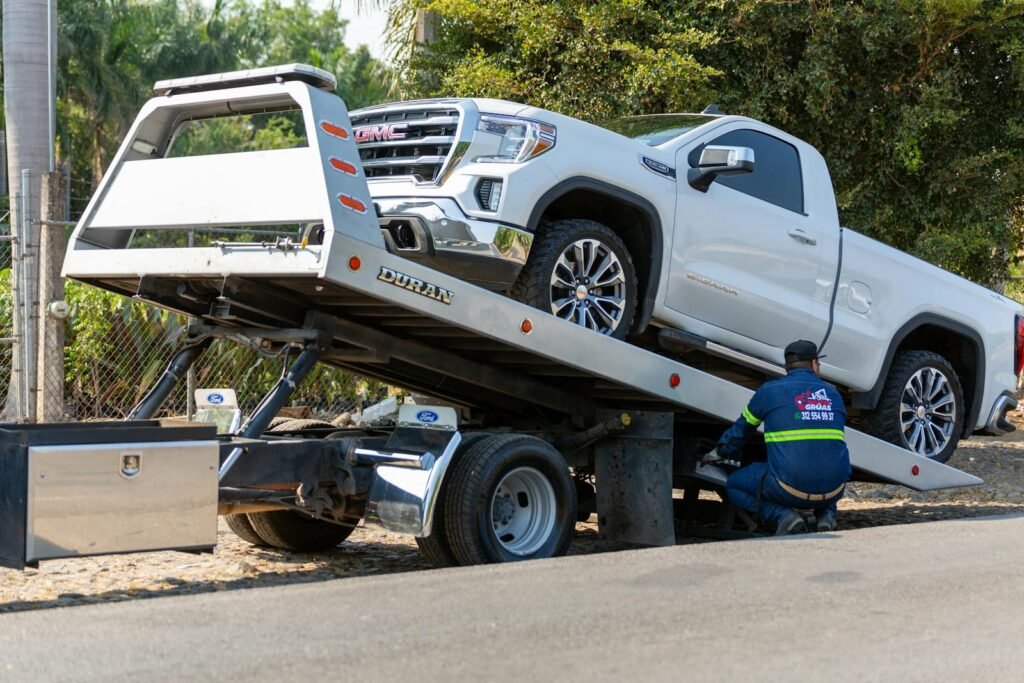Ensure your trailer is securely attached, and your vehicle can handle the load. Check all connections and safety chains.
Towing a trailer requires attention to detail and safety. Properly attaching the trailer and ensuring your vehicle can handle the extra weight are crucial steps. Always verify that safety chains, brake lights, and signals are correctly connected. Understanding your vehicle’s towing capacity helps prevent accidents and mechanical issues.
Practice driving with the trailer in a safe, open space to get comfortable with its handling. Adjust your mirrors to have a clear view of the trailer and surrounding traffic. Regularly inspect your trailer and towing equipment for wear and tear. Keeping these tips in mind ensures a smooth and safe towing experience.
Preparing Your Vehicle
Towing a trailer requires careful preparation. Your vehicle must be ready and safe. This guide will help ensure your vehicle is prepared.
Check The Hitch
The hitch is crucial for towing. Inspect it for any damage. Ensure it is securely attached to your vehicle.
- Verify the hitch size matches the trailer coupler.
- Ensure all bolts and pins are tight.
- Check for rust or wear on the hitch.
Inspect The Trailer
Your trailer must be in good condition. Check the tires first. They should be properly inflated and free of damage.
Next, inspect the lights. Ensure all lights work correctly, including brake lights and turn signals.
| Component | Action |
|---|---|
| Brakes | Test for proper functioning. |
| Safety Chains | Ensure they are properly connected. |
| Load | Check that the load is secure and balanced. |
Finally, ensure the trailer’s registration and insurance are up-to-date. This helps avoid legal issues on the road.
Loading The Trailer
Loading a trailer correctly is crucial for safe towing. Proper loading prevents accidents and ensures a smooth ride. Follow these tips for a safer journey.
Distribute Weight Evenly
Evenly distributing weight in your trailer is very important. Place heavier items in the center. Ensure the load is balanced from side to side.
| Position | Item Weight |
|---|---|
| Center | Heavy items |
| Front | Moderate items |
| Rear | Light items |
Secure The Load
Securing the load is as important as distributing it. Use straps and ropes to tie down items. Prevent any shifting during transit.
- Use strong straps and ropes.
- Tie down items tightly.
- Check the load before starting your trip.
Remember, a well-loaded trailer ensures safety. Follow these steps every time you tow.
Driving Techniques
Towing a trailer behind your vehicle requires special driving techniques. These techniques ensure safety and smooth travel. Pay attention to speed and turns for a secure journey.
Adjusting Speed
When towing a trailer, always adjust your speed. Heavier loads need slower speeds. Maintain a safe distance from other vehicles. This gives you more time to stop. Avoid sudden braking to prevent trailer sway. Use lower gears while descending hills. This helps control the vehicle’s speed without using brakes.
Here are some speed adjustment tips:
- On highways: Drive at or below the speed limit.
- In city areas: Reduce speed more than usual.
- During bad weather: Slow down significantly.
Making Turns
Turning with a trailer needs more space and skill. Always take wider turns to avoid hitting curbs or objects. Check mirrors frequently to ensure the trailer follows safely. Slow down when approaching turns. This helps maintain control and prevents tipping.
Follow these steps for safe turns:
- Signal your turn early.
- Move to the correct lane smoothly.
- Make wider turns than usual.
- Check mirrors for trailer alignment.
Practice turning in empty parking lots. This builds confidence and skill. Remember, patience and caution are key.
Braking And Stopping
Towing a trailer behind your vehicle requires special attention to braking and stopping. With the extra weight of the trailer, your vehicle’s normal braking distance increases significantly. It’s important to understand and apply proper techniques to ensure safety on the road.
Increase Following Distance
When towing a trailer, always increase the following distance between your vehicle and the one in front. This gives you more time to react and stop safely. A good rule of thumb is to maintain at least a four-second gap in normal conditions.
- In rainy or icy conditions, increase the gap to six seconds.
- Extra distance helps prevent collisions.
- This allows for safe deceleration.
Use Trailer Brakes
If your trailer has brakes, make sure to use them. Trailer brakes help reduce stopping distance and improve control. Ensure the trailer brakes are properly adjusted and in good working condition.
Here is a quick checklist:
- Check the brake fluid levels.
- Inspect brake pads and rotors.
- Test the brake response before starting your trip.
Using trailer brakes effectively distributes the braking force, making stops smoother and safer. It also helps prevent wear and tear on your vehicle’s brakes.
Parking And Reversing
Parking and reversing a vehicle with a trailer can be tricky. It requires careful planning and patience. This section will help you master these skills. Learn how to find the right parking spot and reverse safely.
Find Suitable Parking
Finding suitable parking is crucial for safety. Look for a wide and open space. Avoid tight spots and busy areas. If possible, park in a pull-through spot. This makes leaving easier.
Consider these factors for finding the best spot:
- Space Size: Ensure the spot is large enough for your vehicle and trailer.
- Obstacles: Check for curbs, poles, or other obstacles.
- Traffic: Choose a low-traffic area to reduce stress.
Using a table can help visualize parking requirements:
| Factor | Consideration |
|---|---|
| Space Size | Large enough for vehicle and trailer |
| Obstacles | Free from curbs, poles, etc. |
| Traffic | Low-traffic area preferred |
Reverse With Caution
Reversing with a trailer demands extra caution. Go slow and steady. Use your mirrors and turn your head to see behind you. If possible, have someone guide you.
Follow these steps to reverse safely:
- Align your vehicle and trailer straight.
- Check all mirrors for a clear view.
- Move slowly and adjust the steering wheel gently.
- Make small corrections to keep the trailer straight.
Remember these tips to stay safe:
- Take your time. Rushing leads to mistakes.
- Use a spotter. Extra eyes help a lot.
- Practice. The more you do it, the better you get.
Mastering parking and reversing will make your trips smoother. Stay calm and follow these guidelines.
Safety Checks
Towing a trailer behind your vehicle requires special attention. Safety checks are important to ensure a smooth and safe journey. These checks help prevent accidents and mechanical failures.
Regular Inspection
Conduct regular inspections to keep your trailer in top condition. Check the trailer hitch for any signs of wear and tear. Ensure all connections are secure and tight.
Inspect the lights on your trailer. Make sure they are functioning properly. Replace any burnt-out bulbs immediately. Test the brake lights, turn signals, and running lights.
Look at the trailer’s frame and suspension. Check for cracks, rust, or any other damage. Ensure the suspension is working correctly.
Monitor Tire Pressure
Monitoring tire pressure is crucial for safety. Check the tire pressure before every trip. Use a reliable tire gauge to measure the pressure.
Refer to the trailer’s manual for the recommended tire pressure. Over-inflated or under-inflated tires can lead to accidents. Keep a spare tire and tools in your vehicle.
Inspect the tire tread for wear and tear. Replace tires with worn-out tread. Proper tire maintenance ensures better control and fuel efficiency.
| Check | Frequency |
|---|---|
| Hitch and Connections | Every Trip |
| Lights | Every Trip |
| Frame and Suspension | Monthly |
| Tire Pressure | Every Trip |
| Tire Tread | Monthly |
Legal Requirements
Towing a trailer behind your vehicle requires understanding legal requirements. These rules ensure safety on the road. Following these laws helps avoid fines and accidents.
Understand Local Laws
Each state has its own towing laws. Research your state’s regulations before towing. Some states limit the speed while towing. Others require specific equipment like trailer brakes and lights. Check the maximum allowed trailer weight. Exceeding this limit is illegal and dangerous. Use the table below to understand common requirements in various states:
| State | Max Speed Limit (mph) | Trailer Brake Requirement | Max Trailer Weight (lbs) |
|---|---|---|---|
| California | 55 | Yes, over 1,500 lbs | 10,000 |
| Texas | 60 | Yes, over 4,500 lbs | 15,000 |
| Florida | 65 | Yes, over 3,000 lbs | 20,000 |
Ensure Proper Licensing
Having the right license is vital. Some states require a special endorsement or class of license. Check your state’s requirements to see if your current license suffices. If your trailer is heavy, you may need a Commercial Driver’s License (CDL). Here are the steps to ensure proper licensing:
- Visit your state’s DMV website.
- Look for the section on towing and trailers.
- Find out if a special license or endorsement is needed.
- Apply for the necessary license if required.
- Complete any required tests or training.
Having the right license ensures you’re legally allowed to tow. It also helps keep everyone safe on the road.
Emergency Situations
While towing a trailer, emergencies can happen. Knowing what to do can keep you and others safe. This section covers handling breakdowns and responding to accidents.
Handling Breakdowns
A breakdown can be stressful. Stay calm and follow these steps:
- Turn on your hazard lights.
- Pull over to a safe spot.
- Set up reflective triangles or flares.
- Call for roadside assistance.
- Stay inside your vehicle if it’s safe.
Always carry a basic toolkit and spare tire. This can help you fix minor issues.
Responding To Accidents
An accident can be a scary event. Follow these steps to handle it:
- Check for injuries and call 911.
- Move to a safe location if possible.
- Exchange information with other drivers.
- Take photos of the scene.
- Notify your insurance company.
Having a first aid kit in your vehicle is important. This can be crucial in emergencies.
Frequently Asked Questions
When Towing A Trailer Behind Your Vehicle You Should Use?
Use a sturdy hitch, proper lighting connections, and safety chains. Ensure the trailer’s weight is balanced. Adjust mirrors for better visibility. Maintain a safe following distance.
When You Are Towing A Trailer Or Other Vehicle And Following Behind Another Towed Vehicle Or A Three-axle Truck, Stay At Least Feet Behind It.?
Stay at least 300 feet behind a towed vehicle or a three-axle truck. This ensures safety and proper distance.
When You Are Preparing To Tow A Small Trailer Behind Your Vehicle You Are Required By Law To Make Sure The Trailer Has?
The trailer must have functioning lights, including brake, tail, and turn signals. Ensure it has reflective markers, a secure hitch, safety chains, and properly inflated tires.
When You Are Towing A Trailer You Should?
Ensure your trailer is securely attached. Check lights and brakes. Distribute weight evenly. Drive at safe speeds. Avoid sudden maneuvers.
Conclusion
Mastering trailer towing enhances safety and confidence on the road. Always check your vehicle’s capacity and secure the load. Practice driving with the trailer in controlled environments. Follow these tips to ensure a smooth and safe towing experience. Stay vigilant, drive responsibly, and enjoy your travels with peace of mind.


